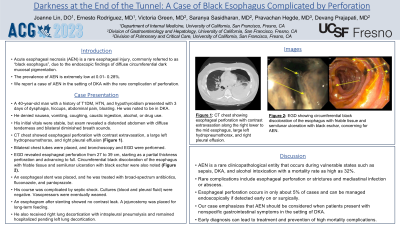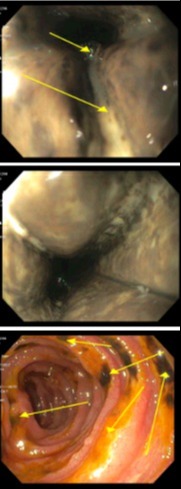Sunday Poster Session
Category: Esophagus
P0511 - Darkness at the End of the Tunnel: A Case of Black Esophagus Complicated by Perforation
Sunday, October 22, 2023
3:30 PM - 7:00 PM PT
Location: Exhibit Hall

Has Audio
- JL
Joanne Lin, DO
UCSF Fresno
Presenting Author(s)
Joanne Lin, DO, Ernesto Rodriguez, MD, Victoria Green, MD, Saranya Sasidharan, MD, Pravachan Hegde, MD, Devang Prajapati, MD
UCSF Fresno, Fresno, CA
Introduction: Acute esophageal necrosis (AEN) is a rare esophageal injury commonly referred to as “black esophagus” due to the endoscopic findings of diffuse, circumferential dark mucosal pigmentation. The prevalence of AEN is very low at 0.01 to 0.28%. We report a case of black esophagus in the setting of diabetic ketoacidosis (DKA) with the rare complication of perforation.
Case Description/Methods: A 40-year-old man with a history of type 1 diabetes, hypertension, and hypothyroidism presented with three days of dysphagia, hiccups, abdominal pain, bloating, and was found to be in DKA. He denied nausea, vomiting, coughing, caustic ingestion, alcohol, or recreational drug use. His initial vitals were stable. Physical exam revealed a distended abdomen with diffuse tenderness and bilateral diminished breath sounds. CT chest showed esophageal perforation with contrast extravasation along the right lower to the mid esophagus, large left hydropneumothorax, and right pleural effusion. Bilateral chest tubes were placed, and bronchoscopy and esophagogastroduodenoscopy (EGD) were performed. EGD revealed esophageal perforation from 27 to 39 cm, starting as a partial thickness perforation and advancing to full thickness, circumferential black discoloration of the esophagus with friable tissue, and semilunar ulceration with black eschar (Figure 1). An esophageal stent was placed and he was treated with broad-spectrum antibiotics, fluconazole, and pantoprazole. His course was complicated by septic shock. Cultures (blood and pleural fluid) were negative and vasopressors were eventually weaned. An esophagram after stenting showed no contrast leak. A jejunostomy was placed for long-term feeding. He also received right lung decortication with intrapleural pneumolysis and remained hospitalized pending left lung decortication.
Discussion: AEN is a rare clinicopathological entity, often arising during vulnerable states such as sepsis, DKA, and alcohol intoxication. Rare complications include esophageal perforation or strictures, mediastinal infection or abscess, and death with a mortality rate as high as 32%. Perforation, which occurs in only about 5% of cases, can be managed endoscopically or surgically if detected early on. This case emphasizes that AEN should be considered when patients present with nonspecific gastrointestinal symptoms in the setting of DKA. Early diagnosis can lead to treatment and prevention of high mortality complications.

Disclosures:
Joanne Lin, DO, Ernesto Rodriguez, MD, Victoria Green, MD, Saranya Sasidharan, MD, Pravachan Hegde, MD, Devang Prajapati, MD. P0511 - Darkness at the End of the Tunnel: A Case of Black Esophagus Complicated by Perforation, ACG 2023 Annual Scientific Meeting Abstracts. Vancouver, BC, Canada: American College of Gastroenterology.
UCSF Fresno, Fresno, CA
Introduction: Acute esophageal necrosis (AEN) is a rare esophageal injury commonly referred to as “black esophagus” due to the endoscopic findings of diffuse, circumferential dark mucosal pigmentation. The prevalence of AEN is very low at 0.01 to 0.28%. We report a case of black esophagus in the setting of diabetic ketoacidosis (DKA) with the rare complication of perforation.
Case Description/Methods: A 40-year-old man with a history of type 1 diabetes, hypertension, and hypothyroidism presented with three days of dysphagia, hiccups, abdominal pain, bloating, and was found to be in DKA. He denied nausea, vomiting, coughing, caustic ingestion, alcohol, or recreational drug use. His initial vitals were stable. Physical exam revealed a distended abdomen with diffuse tenderness and bilateral diminished breath sounds. CT chest showed esophageal perforation with contrast extravasation along the right lower to the mid esophagus, large left hydropneumothorax, and right pleural effusion. Bilateral chest tubes were placed, and bronchoscopy and esophagogastroduodenoscopy (EGD) were performed. EGD revealed esophageal perforation from 27 to 39 cm, starting as a partial thickness perforation and advancing to full thickness, circumferential black discoloration of the esophagus with friable tissue, and semilunar ulceration with black eschar (Figure 1). An esophageal stent was placed and he was treated with broad-spectrum antibiotics, fluconazole, and pantoprazole. His course was complicated by septic shock. Cultures (blood and pleural fluid) were negative and vasopressors were eventually weaned. An esophagram after stenting showed no contrast leak. A jejunostomy was placed for long-term feeding. He also received right lung decortication with intrapleural pneumolysis and remained hospitalized pending left lung decortication.
Discussion: AEN is a rare clinicopathological entity, often arising during vulnerable states such as sepsis, DKA, and alcohol intoxication. Rare complications include esophageal perforation or strictures, mediastinal infection or abscess, and death with a mortality rate as high as 32%. Perforation, which occurs in only about 5% of cases, can be managed endoscopically or surgically if detected early on. This case emphasizes that AEN should be considered when patients present with nonspecific gastrointestinal symptoms in the setting of DKA. Early diagnosis can lead to treatment and prevention of high mortality complications.

Figure: EGD showing circumferential black discoloration of the esophagus with friable tissue and semilunar ulceration with black eschar concerning for AEN.
Disclosures:
Joanne Lin indicated no relevant financial relationships.
Ernesto Rodriguez indicated no relevant financial relationships.
Victoria Green indicated no relevant financial relationships.
Saranya Sasidharan indicated no relevant financial relationships.
Pravachan Hegde indicated no relevant financial relationships.
Devang Prajapati indicated no relevant financial relationships.
Joanne Lin, DO, Ernesto Rodriguez, MD, Victoria Green, MD, Saranya Sasidharan, MD, Pravachan Hegde, MD, Devang Prajapati, MD. P0511 - Darkness at the End of the Tunnel: A Case of Black Esophagus Complicated by Perforation, ACG 2023 Annual Scientific Meeting Abstracts. Vancouver, BC, Canada: American College of Gastroenterology.
